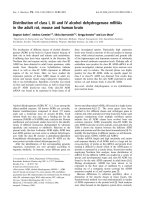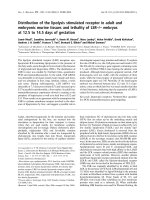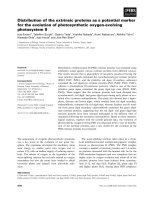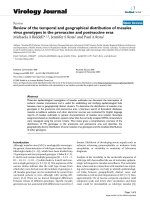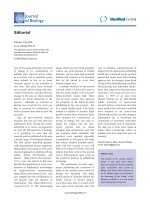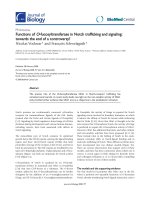Báo cáo sinh học: "Distribution of the copia transposable element in the repleta group of Drosophila" doc
Bạn đang xem bản rút gọn của tài liệu. Xem và tải ngay bản đầy đủ của tài liệu tại đây (1.24 MB, 16 trang )
Original
article
Distribution
of
the
copia
transposable
element
in
the
repleta
group
of
Drosophila
O
Francino,
O
Cabre
A
Fontdevila
Universitat
!lu!onoTTto
de
Barcelona,
Departament
de
Gen!tica
i
de
Micro6iologia,
08193
Bellaterra,
Barcelona,
Spain
(Received
28
April
1992;
accepted
5
August
1993)
Summary -
The
occurrence
of
the
copia
transposable
element
in
18
species
of
the
repleta
group
of
Drosophila
has
been
studied
using
the
Southern
technique.
The
homologous
sequence
of
copia
was
detected,
either
with
radioactive
or
non-radioactive
nucleic
acid
detection
systems,
as
a
pattern
of
multiple
bands
in
species
of
the
mercatorum
and
mulleri
subgroups.
Nevertheless,
this
sequence
was
not
detected
in
the
hydei
subgroup.
The
intraspecific
polymorphism
in
the
pattern
of
bands
indicates
that
this
sequence
is
likely
to
be
mobile.
Some
of
the
results
could
suggest
the
existence
of
restriction
polymorphism
of
the
copia
homologous
sequence
in
D
koepferae
populations.
The
partial
sequencing
of
2
independent
clones
isolated
from
D
buzzatii
clearly
establishes
that
these
elements
are
related
and
are
likely
to
be
the
same.
copia
transposable
element
/
Drosophila
/
repleta
group
Résumé -
Distribution
de
l’élément
transposable
copia
dans
le
groupe
repleta
de
la
drosophile.
La
présence
de
l’élément
copia
a
été
recherchée
dans
18
espèces
de
drosophiles
du
groupe
repleta
par
la
technique
de
Southern.
Plusieurs
bandes
ont
été
détectées
dans
les
sous-groupes
mercatorum
et
mulleri
à
l’aide
de
sondes
radioactives
et
non
radioactives.
En
revanche,
aucune
séquence
n’a
été
décelée
dans
le
sous-groupe
hydei.
Le
polymorphisme
intraspécifique
de
la
position
des
bandes
indique
que
ces
séquences
sont
vraisemblablement
mobiles.
ChezD
koepferae il
existe
un
polymorphisme
des
sites
de
restriction
de
la
séquence
homologue
copia.
Enfin,
la
séquence
partielle
obtenue
pour
2
clones
indépendants
de
D
buzzatti
indique
que
les
2
éléments
sont
apparentés
et
probablement
les
mêmes.
élément
transposable
copia
/
drosophile
/
groupe
repleta
*
Correspondence
and
reprints
INTRODUCTION
Copia
retrotransposon
from
D
melanogaster
is
1
of
the
best
known
retroviral
type
elements
in
the
genus
Drosophila
(Mount
and
Rubin,
1985;
Emori
et
at,
1985).
Retrotransposons
are
recognized
by
structural
and
functional
similarities
to
integrated
retroviruses.
They
are
bound
by
long
terminal
repeats
(LTRs)
at
their
termini
and
contain
open
reading
frames
resembling
gag
and
pol
genes
from
retroviruses
(Finnegan
1989;
see
Bingham
and
Zachar,
1989
for
review).
There
are
2
distinct
lineages
of
retrotransposons
based
on
the
order
of
the
gene
complement
and
reverse
transcriptase
(RT)
amino-acid
sequence
relationships
(Xiong
and
Eickbush,
1988,
1990;
McClure,
1992).
More
closely
related
to
retroviruses
and
sharing
a
common
ancestor
with
caulimoviruses,
is
a
group
including
several
retrotransposons
of
D
melanogaster
(gypsy,
17.6,
412,
297,
micropia), S
cerevisae
(Ty3)
and
B
mori
(Mag).
On
the
other
hand,
copia-like
elements
have
a
gene
order
which
is
different
from
all
other
retroid
family
members
in
that
the
integrase
domains
are
located
at
the
amino
terminal
of
the
RT
domain.
Retrotransposons
from
distantly
related
taxonomic
groups
such
as
D
melanogaster
(copia
and
1731),
S
cerevisae
(Tyl
and
Ty2),
A
thaliana
(Tal)
and
N
tabacum
(Tntl)
are
clustered
in
this
latter
group
(Xiong
and
Eickbush
1990,
McClure
1992).
The
presence
of
the
copia
element
has
been
reported
in
the
major
Drosophila
radiations,
suggesting
an
ancient
origin
of
this
component
in
the
genome
(Martin
et
at,
1983,
Stacey
et
at,
1986).
Nevertheless,
the
distribution
of
copia
is
discontinuous
within
the
different
radiations
analysed.
In
the
virilis-repleta
radiation,
hybridizing
sequences
have
been
found
in
the
mulleri
and
mercatorum
subgroups
(repleta
group),
but
no
detectable
hybridization
was
observed
in
the
hydei
subgroup
(repleta
group)
or
in
any
of
the
representatives
of
the
virilis
group.
However,
even
in
closely
related
species,
the
relative
abundance
of
the
copia
element
can
be
highly
variable.
In
the
melanogaster
subgroup
the
number
of
dispersed
copies
of
copia
ranges
from
60
in
D
melanogaster
(Finnegan
et
at,
1978)
to
0
in
D
yakuba
and
D
erecta
(Dowsett,
1983).
Similar
differences
were
observed
in
the
obscura
group,
with
more
than
30
copies
of
the
homologous
sequence
in
D
pse!doobscura
and
no
detectable
copies
in
D
subobscura
(Martin
et
at,
1983).
A
preliminary
approach
to
the
molecular
evolution
of
the
transposable
elements
is
to
investigate
their
presence
(or
absence)
in
a
species
group
in
which
the
biogeographic
and
phylogenetic
relationships
are
known.
The
repleta
group
of
Drosophila
has
been
thoroughly
studied
and
its
phylogeny
and
biogeography
have
been
deduced
(Wasserman
1982;
Fontdevila
1982;
Ruiz
et
at,
1982).
It
is
distantly
related
to
the
melanogaster
group
(Throckmorton,
1982),
but
copia
homologous
sequences
have
been
detected
in
some
of
its
species
(Martin
et
at,
1983;
Stacey
et
at,
1986).
Here
we
expand
the
survey
to
18
species
of
this
group
comprising
3
different
subgroups
(mulleri,
mercatorum
and
hydei).
The
2
sibling
species
D
buzzatii
and
D
koepferae
have
been
studied
in
more
detail
by
analysing
strains
from
different
geographic
origins.
Moreover,
partial
sequencing
of
2
independent
clones
isolated
from
D
buzzatii
demonstrates
the
presence
of
copia
itself
in
this
species.
Characterization
of
copia
in
different
species
is
a
tool
to
solve
some
questions,
such
as
which
molecular
features
act
as
functional
determinants
and
the
nature
of
the
evolutionary
dynamics
of
the
element
in
the
genus
Drosophila.
MATERIAL
AND
METHODS
Drosophila
stocks
The
strains
used
were
originated
from
collections
made
by
1
of
us
(AF)
and
coworkers;
there
are
some
exceptions:
D
mulleri
and
D
wheeleri
were
provided
by
W
Heed;
D
buzzatii
populations
from
Tunis
and
Chile
were
provided
by
J
David
and
D
Brncic,
respectively;
and
D
borborerrea
and
D
serido
were
purchased
from
Bowling
Green.
Probe
The
pDmcopia
was
kindly
provided
by
J
Modolell.
It
is
a
full-length
sequence
of
copia
obtained
from
cDm5002
(Dunsmuir
et
al,
1980),
cloned
in
pUC8.
Restriction
enzymes
The
enzymes
were
purchased
from
Boehringer
Mannheim
and
used
according
to
the
supplier’s
instructions.
Genomic
DNA
extraction,
agarose
gel
electrophoresis
and
Southern
blotting
Genomic
DNA
extraction
was
performed
as
described
previously
(Pinol
et
al,
1988).
Digested
genomic
DNA
was
loaded
on
a
0.6%
agarose
gel
(0.5
x
14
x
20
cm).
Electrophoresis
was
carried
out
at
20-25
V
overnight.
When
using
non-radioactive
DNA
detection
methods,
the
amount
of
DNA
loaded
in
each
lane
was
adjusted
by
a
correction
factor
obtained
from
the
densitometric
analysis
of
an
electrophoresis
previously
carried
out.
Blotting
on
a
nitrocellulose
filter
(Hybond
C
and
Hybond
C-EXTRA)
was
as
described
in
Maniatis
et
al
(1982).
Hybridization
The
pDmcopia
probe
was
labelled
with
either
32
P-ATP,
biotin-11-dUTP
(using
nick-translation)
or
digoxigenin-11-dUTP
(using
a
random
primed
reaction).
When
using
32
P-ATP-labelled
probes
the
hybridization
conditions
were
the
same
as
those
described
in
Maniatis
et
al
(1982).
The
post-hybridization
washes
were
always
carried
out
at
65°C,
twice
in
2
x
SSC
for
15
min,
and
once
in
2
x
SSC
0.1%
SDS
for
30
min,
which
represents
medium
stringency
wash
conditions
(Stacey
et
al,
1986).
The
autoradiography
was
exposed
24-36
h
at
-70°C
with
an
intensifying
screen.
When
using
biotin-
or
digoxigenin-labelled
probes,
the
hybridization
was
performed
at
42°C
in
50%
formamide
and
washes
at
rt
twice
in
2
x
SSC,
0.1%
SDS
for
5
min,
and
then
at
50°C
twice
in
0.1
x
SSC,
0.1%
SDS
for
15
min
(described
in
the
non-radioactive
nucleic
acid
detection
systems
from
BRL
and
Boehringer
Mannheim).
Cloning
and
sequencing
The
genomic
library
from
D
buzzatii
DNA
was
prepared
as
described
by
Pifiol
et
al
(1988)
and
screened
with
pDmcopia
probe.
DNA
from
positive
lambda
clones
was
prepared,
BamHi,
EcoRI,
HinDIII
and
Sail
digested
and
hybridized
with
the
same
probe.
Restriction
fragments
containing
copia
from
independent
lambda
clones
were
subcloned
into
pTZ-18U
(US,
Biochemical)
and
partially
sequenced
by
the
dideoxy
chain
termination
method
using
Sequenase
(US
Biochemical)
or
T7
DNA
polymerase
(Pharmacia).
For
sequence
comparisons
the
FASTA
program
from
the
EMBL
data
bank
was
used.
RESULTS
Distribution
of copia
in
the
repleta
group
In
order
to
test
the
presence
of
copia
in
different
species
of
the
repleta
group,
an
initial
qualitative
screening
was
carried
out
with
species
belonging
to
clusters
6uzzatii,
martensi.s
and
mulleri
(mulleri
subgroug,
Wasserman,
1982).
These
clusters
were
chosen
because
the
presence
of
copia
in
D
mulleri
has
previously
been
described
(Stacey
et
al,
1986).
Southern
blots
of
EcoRI-digested
DNAs
were
hybridized
with
32
P-labelled
pDmcopia
probe.
Under
medium
stringency
wash
conditions,
autoradiography
shows
patterns
of
multiple
and
discrete
bands
(fig
1-3).
The
time
required
to
obtain
a
visible
signal
in
the
repleta
group
species
clearly
overexposes
the
band
corresponding
to
D
melanogaster.
The
patterns
were
different
for
each
species
tested,
and
indicate
the
presence
of
a
repetitive
sequence
homologous
to
copia
in
the
repleta
group.
Some
of
the
bands
detected
are
shorter
than
the
copia
element
which
is
5
kb
long,
suggesting
that
the
homologous
sequence
has
at
least
1
internal
EcoRI
restriction
site
or
some
defective
representatives
in
the
species
tested.
Twelve
strains
of
D
buzzatii
populations
from
different
geographic
localities
were
analysed
for
the
genomic
distribution
of
the
copia
element
(fig
2).
Some
differences
are
detected
in
the
relative
intensity
and
in
the
presence
or
absence
of
a
given
band,
but
the
different
strains
share
most
of
their
bands,
suggesting
a
similar
distribution
of
copia
in
the
genome
of
this
species.
Major
differences
are
observed
in
patterns
obtained
for
populations
of
D
koepfe-
rae
(Fontdevila
et
al,
1988)
and
its
symmorphic
species
D
serido
(fig
3).
In
the
Argentinian
populations
of
D
koepferae,
all
of
the
signal
is
virtually
reduced
to
an
intense
3.4
kb
band,
while
the
rest
of
the
bands
are
extremely
faint.
This
pattern
could
be
due
to
either
an
internal
EcoRI
fragment
or
a
tandem
organization
of
the
element
in
these
populations.
In
order
to
test
the
origin
of
this
prominent
band,
EcoRI-
and
HindIII-digested
genomic
DNA
from
Bolivian
and
Argentinian
populations
were
hybridized
with
digoxigenin-labelled
pDmcopia
probe.
A
pattern
of
multiple
bands
was
observed
in
HindIII
digestions
(fig
4b),
which
favours
the
idea
of
the
presence
of
an
EcoRI
internal
fragment
instead
of
a
tandem
array
of
the
element
in
the
genome
of
D
koepferae.
The
intensity
of
bands
is
greater
for
the
lanes
corresponding
to
Argentinian
populations
when
the
same
amount
of
DNA
is
loaded
(fig
4,
bands
2-4).
We
have
also
used
a
biotin-labelled
pDmcopia
probe
to
extend
the
survey
of
the
presence
of
copia
in
the
mulleri
subgroup
species.
We
included
DNA
from
hydei
and
mercatorum
subgroups
as
additional
reference
points,
for
it
is
known
that
copia
is
detected
in
D
mercatorum
but
not
in
D
hydei
DNA
(Martin
et
al,
1983;
Stacey
et
al,
1986).
The
DNA
loaded
in
each
band
was
adjusted
beforehand
(see
Material
and
methods)
in
order
to
obtain
both
qualitative
and
quantitative
results.
As
it
can
be
seen
in
figure
5,
a
sequence
homologous
to
the
copia
element
was
detected
with
the
biotin-labelled
pDmcopia
probe
in
all
the
mulleri
subgroup
species
tested,
but
no
detectable
hybridization
was
observed
in
the
hydei
subgroup
(represented
here
by
D
hydei
and
D
hydeoides).
The
relative
intensity
of
the
bands
was
greater
for
the
lanes
corresponding
to
D
mercatorum,
D
mulleri
and
D
buzzatii.
of
copia
from
D
buzzatii
As
a
preliminary
step
for
the
molecular
characterization
of
the
copia
element
in
D
buzzatii,
a
genomic
library
was
screened
with
digoxigenin-labelled
pDmcopia
probe.
Two
independent
clones
were
isolated
and
restriction
fragments
hybridizing
with
pDmcopia
were
subcloned
and
partially
sequenced.
The
alignment
of
the
sequences
with
copia
from
D
melanogaster
(Dm
copia)
is
shown
in
figure
6.
The
sequenced
region
of
each
of
the
clones
aligns
with
Dm
copia
in
different
positions:
Db
07X
(A
5)
aligns
in
the
3’
region
of
integrase
while
Db
05TqE
(A
12)
corresponds
to
reverse
transcriptase.
The
identity
between
D
buzzatii
subclones
and
DM
copia
is
higher
than
75%
at
the
nucleotide
level
(77.4%
for
integrase
and
76.5%
for
reverse
transcriptase)
and
about
70%
at
the
amino-acid
level
(74.2
and
68.9%,
respectively).
When
considering
similarities
at
the
amino-
acid
level,
the
percentage
increases
to
95.2%
for
integrase
region
and
to
88.8%
for
reverse
transcriptase.
It
is
noteworthy
that
copia
from
D
melanogaster
is
the
only
Dro.sophila-transposable
element
sequence
that
aligns
with
our
subclones
at
the
nucleotide
level
when
using
the
FASTA
program.
The
sequence
identity
with
other
elements
is
not
enough
to
allow
their
alignment
with
D
buzzatii
subclones.
On
the
other
hand,
amino-acid
sequences
obtained
for
putative
ORFs
of
both
the
integrase
and
reverse
transcriptase
regions
align
with
elements
from
distantly
related
taxonomic
species,
such
as
Nicotiana
tabacum
or
Arabidopsis
tltaliana,
but
with
no
other
Drosophila-transposable
element.
Only
1731
from
D
melanogaster
is
aligned
with
Db
05TqE
at
the
amino-acid
sequence
level
(reverse
transcriptase),
but
the
percentage
of
identity
changes
from
68.9%
between
D
buzzatii
subclone
and
Dm
copia
to
32.2%
between
the
same
subclone
and
1731.
In
order
to
test
the
reliability
of
pDmcopia
hybridization
signals
in
the
repleta
group
species,
the
Db
05TqE
subclone
from
D
buzzatii
was
used
as
a
probe
for
D
buzzatii
and
D
I!oepferae
EcoRI-digested
DNA
(fig
7).
The
hybridization
patterns
obtained
for
D
koepferae
were
compared
with
those
obtained
with
the
pDmcopia
when
the
same
strains
were
used
(see
fig
4,
bands
1,4;
fig
7,
bands
1,
2).
The
3.4
kb
EcoRI
internal
fragment
is
observed
with
both
probes
in
the
bands
corresponding
to
Argentinian
populations
(fig
4,
band
4;
fig
7,
band
2).
The
hybridization
signal
is
greater
for
the
Db
05TqE
probe,
since
it
contains
a
fragment
of
the
element
from
a
closely
related
species
and
a
higher
sequence
conservation
is
expected.
However,
the
relative
intensity
of
the
faint
bands
in
relation
to
the
internal
fragment
in
each
band
is
equivalent
with
both
probes.
Moreover,
the
signal
is
always
more
intense
for
the
Argentinian
than
the
Bolivian
populations
when
the
same
amount
of
DNA
is
loaded.
The
coincidence
of
these
results
demonstrates
the
specificity
of
pDmcopia
hybridization
in
the
repleta
group.
DISCUSSION
We
have
analysed
the
occurrence
of
copia
in
the
repleta
group.
The
results
obtained
are
summarized
in
table
I.
It
can
be
seen
that
a
sequence
homologous
to
copia
from
D
melanogaster
(Dm
copia)
is
detected
in
all
the
tested
species
from
the
mulleri
and
mercatorum
subgroups.
Therefore,
using
both
radioactive
and
non-radioactive
detection
methods,
our
results
are
in
good
agreement
with
those
reported
by
Martin
et
al
(1983)
and
Stacey
et
al
(1986),
where
a
sequence
homologous
to
Dm
copia
was
detected
in
the
repleta
group
species
D
mulleri
and
D
mercatorum.
The
negative
result
obtained
here
for
D
hydei
is
also
in
agreement
with
the
work
of
Martin
et
al
(1983),
where
no
complementary
sequences
were
detected
in
this
species.
We
have
also
shown
that
copia
is
not
detected
in
D
hydeoides.
The
negative
result
in
both
species
of
the
hydei
subgroup
could
be
explained
by
either
the
absence
of
copia
in
this
subgroup
or
a
greater
divergence
rate
of
the
element
in
these
species,
which
would
avoid
detection
by
hybridization
with
the
pDmcopia
probe.
Both
alternatives
suggest
particular
evolutionary
events
of
the
copia
element
in
the
hydei
subgroup
in
relation
to
other
repleta
subgroups.
In
the
mulleri
subgroup
species
tested,
the
similarity
with
the
pDmcopia
probe
is
enough
to
detect
the
homologous
sequence
in
the
repleta
group
species
under
medium
stringency
wash
conditions
(Stacey
et
al,
1986).
The
hybridization
signal
is
heterogeneous
between
species,
suggesting
different
degrees
of
similarity
between
the
copia
element
from
the
repleta
group
and
D
melanogaster.
However,
similar
patterns
of
hybridization
are
obtained
with
both
the
pDmcopia
and
D
buzzatii
probes
for
D
buzzatii
and
D
koepferae
DNA,
although
the
degree
of
divergence
between
them
is
nearly
30%
at
the
DNA
level.
We
therefore
deduce
that
weak
signals
obtained
with
pDmcopia
probe
in
Southern
blots
are
due
to
sequence
divergence
or
the
low
number
of
copies
of
the
copia
element
rather
than
cross
hybridization
of
the
probe
with
other
transposable
elements
present
in
these
species.
Differences
are
also
observed
between
closely
related
species
such
as
D
koepferae
and
D
buzzatii.
Populations
from
different
geographic
localities
from both
species
were
analysed
for
the
genomic
distribution
of
copia.
Polymorphism
in
the
genomic
location
of
the
elements
is
detested
as
heterogeneity
in
the
patterns
of
the
bands
obtained
for
strains
of
the
same
species,
according
to
the
great
variability
in
the
reported
chromosomal
distribution
of
copia
(Strobel
et
al,
1979;
Montgomery
and
Langley,
1983;
Bi6mont
et
al,
1985;
Pasyukova
et
al,
1986;
Ronsseray
and
Anxolab6h!re,
1986;
Leigh-Brown
and
Moss,
1987).
The
most
striking
differences
in
the
pattern
of
bands
are
observed
between
Argentinian
and
Bolivian
populations
of
D
koepferae.
The
prominent
band
observed
in
the
former
could
be
due
to
the
presence
of
an
internal
EcoRI
fragment
or
a
cluster
where
the
copia
element
and
its
flanking
regions
would
be
regularly
interspersed
(Rubin
1983;
Yamaguchi
et
al,
1987;
Belyaeva
et
al,
1984,
Crozatier
et
al,
1988;
Di
Franco
et
al,
1989).
Using
a
second
restriction
enzyme,
HindIII,
a
pattern
of
multiple
bands
is
obtained
with
a
pDmcopia
probe
in
both
Argentinian
and
Bolivian
populations
of
D
koepferae
(fig
4b).
It
is
noteworthy
that
hybridizing
fragments
are
longer
than
5
kb,
suggesting
the
lack
of
a
HindIII
restriction
target
site
in
the
copia
sequence.
The
pattern
of
multiple
bands
obtained
removes
the
possibility
of
a
tandem
arrangement
of
the
element
and
suggests
that
the
prominent
band
in
the
Argentinian
populations
is
due
to
the
presence
of
a
3.4
kb-long
EcoRI
internal
restriction
fragment.
It
is
interesting
to
note
that
a
single
change
in
an
internal
EcoRI
site
could
explain
the
pattern
observed.
In
the
populations
where
only
1
EcoRI
internal
site
is
present,
a
pattern
of
multiple
bands
is
expected,
with
the
fragment
lengths
determined
by
the
external
flanking
EcoRI
sites.
The
presence
of
a
second
EcoRI
internal
site
generates
a
pattern
with
a
prominent
band
corresponding
to
the
internal
restriction
fragment.
Therefore,
if
copies
of
the
element
with
either
1
or
2
internal
EcoRI
sites
coexist
in
the
same
genome,
pattern
of
bands
obtained
in
EcoRI-digested
DNA
will
depend
on
the
relative
frequency
of
each
class
of
element
in
the
population
tested.
The
relative
intensity
of
the
EcoRI
internal
fragment
in
relation
to
the
other
bands
is
lower
in
Bolivian
than
in
Argentinian
populations.
Moreover,
a
clear
difference
in
both
number
and
intensity
of
bands
is
observed
between
D
koepferae
populations
of
different
geographic
origins.
These
results
suggest
the
existence
of
polymorphism
in
the
copia
element
between
Argentinian
and
Bolivian
populations
of
D
koepferae,
in
which
a
certain
degree
of
genetic
divergence
has
previously
been
described
(Fontdevila
et
al,
1988).
On
the
other
hand,
patterns
of
bands
obtained
for
South
American
and
European
populations
of
D
buzzatii
are
rather
similar,
which
means
that
polymorphism
in
the
genomic
distribution
of
copia
in
this
species
is
very
low.
Such
a
regular
distribution
of
the
element
could
be
due
to
the
absence
of
recent
transposition
events
or
to
genetic
drift
of
a
common
ancestral
set
of
inactive
copies
of
the
element.
Knowing
the
degree
of
divergence,
we
can
expect
that
the
homologous
elements
will
remain
unsolved
until
both
active
and
inactive
copies
of
the
same
element
are
characterized
in
closely
and
distantly
related
species.
We
have
analysed
2
closely
related
species,
D
koepferae
and
D
buzzatii
in
more
detail,
and
different
situations
are
observed.
In
one,
an
EcoRI
restriction
polymorphism
is
observed
in
the
element.
In
the
other
a
set
of
ancestral
inactive
copies
is
likely
to
be
responsible
for
the
observed
patterns
of
hybridization.
The
partial
sequencing
of
2
independent
clones
isolated
from
D
buzzatii
reveals
a
70-75%
identity
in
both
nucleotide
and
amino-acid
sequences
between
D
buzzatii
and
Dm
copia
(the
similarity
raises
to
89-95%
at
the
amino-acid
level).
It
is
interesting
to
note
that
no
other
transposable
element
from
D
melanogaster
is
similar
enough
to
be
aligned
with
D
buzzatii
sequences
in
the
EMBL
data
bank
at
the
nucleotide
level
with
the
FASTA
program,
and
only
the
amino-acid
sequence
of
the
1731
element
from
D
rnelanogaster
is
aligned
with
the
D
buzzatii
RT
subclone.
In
this
case
the
amino-acid
identity
percentage
goes
from
68.9
to
32.2%
in
relation
to
Dm
copia.
It
is
well
known
that
divergence
rate
between
homologous
retroviral
proteins
is
faster
than
for
structural
genes
and
the
high
mutation
rate
is
attributed
to
the
low
fidelity
of
RT
(for
a
review,
see
Doolittle
et
al,
1989).
Although
RT
is
the
slowest
changing
of
the
retroviral
gene
products,
the
amino-acid
sequence
divergence
among
different
retrotransposons
is
greater
than
60%.
Moreover,
retrotransposons
are
clustered
in
2
different
branches
according
to
RT
phylogenies.
The
copia
element
from
D
melanogaster
is
clustered
with
retrotransposons
from
very
different
organisms,
such
as
yeasts
(Tyi,
S
cerevisiae)
or
plants
(Tnti,
N
tabacum;
Tal,
A.
thaliana),
and
only
with
one
other
from
Drosophila
(1731,
D
melanoga.ster).
The
nucleotide
identity
percentage
between
D
B!zzatii
isolated
sequences
and
Dm
copia
is
similar
to
that
obtained
for
structural
genes,
such
as
Adh
(72.3%
at
the
nucleotide
level).
If
we
consider
a
higher
rate
of
divergence
for
retrotransposons
than
for
structural
genes,
we
could
postulate
any
mechanism
accounting
for
the
conservation
of
the
element
sequence
between
D
melanogaster
and
D
buzzatii,
such
as
horizontal
transmission
of
the
element
between
these
species.
Evidence
for
,
the
horizontal
transmission
of
other
Drosophila
elements
between
phylogenetically
distant
species
has
previously
been
described
(Maruyama
and
Hartl,
1991,
Daniels
et
al,
1990).
However,
the
copia
element
is
detected
in
all
the
tested
mercatorum
and
mulleri
subgroup
species,
and
the
absence
of
any
homologous
sequence
is
confirmed
in
the
hydei
subgroup.
In
this
case,
we
postulate
transmission
of
the
copia
element
into
the
mulleri
subgroup
after
the
separation
of
hydei
subgroup
and
before
the
irradiation
of
the
mulleri
and
mercatorum
subgroups.
From
that
moment,
the
copia
element
in
these
species
would
have
changed
in
relation
to
D
melanogaster
according
to
the
predicted
rate
of
divergence
for
retrotransposons.
On
the
other
hand,
if
the
copia
element
was
present
in
ancestral
species
before
the
irradiation
of
the
repleta
group,
we
can
postulate
the
loss
of
the
element
in
the
hydei
subgroup
genomes.
Other
retrotransposons
have
been
isolated
and
sequenced
from
the
virilis-repleta
radiation
species
such
as
micropia
from
D
hydei
(Lankenau
et
al,
1988,
1990)
and
gypsy
from
D
virilis
(Mizrohki
et
al,
1991).
Amino-acid
identity
percentage
ranges
from
70
to
90%
between
homologous
retrotransposons
from
these
species
and
D
melanogaster,
which
agrees
with
our
results.
Therefore,
the
high
levels
of
nucleotide
and
amino-acid
sequences
identity
be-
tween
the
D
6uzzatii
element
and
the
copia
from
D
melanogaster
clearly
establishes
that
the
elements
are
related
and
are
likely
to
be
the
same.
ACKNOWLEDGMENTS
This
work
was
supported
by
grant
PB86/0064
from
the
DGICYT
(Ministerio
de
Educacion
y
Ciencia)
awarded
to
AF,
grant
113088
from
Universitat
Autonoma
de
Barcelona
awarded
to
OC
and
by
a
fellowship
from
the
Programa
de
Formació
d’lnvestigadors
(Universitat
Autonoma
de
Barcelona)
awarded
to
OF.
We
are
very
grateful
to
W
Heed,
J
David
and
D
Brncic,
for
provision
of
some
of
the
strains
used
in
this
work,
and
J
Pinol
for
help
in
obtaining
genomic
libraries.
REFERENCES
Belyaeva
ES,
Ananiev
EV,
Gvozdev
VA
(1984)
Distribution
of
mobile
dispersed
genes
(mdg-1
and
mdg-3)
in
the
chromosomes
of
Drosophila
!zelanoga.ster.
Chro-
mosoma
(Berl)
90,
16-19
Bi6mont
C,
Belyaeva
ES,
Pasyukova
EG,
Kogan
G
(1985)
Mobile
gene
localization
and
viability
in
Drosophila
melanogaster.
Experientia
(Basel)
41,
1474-1476
Bingham
PM,
Zachar
Z
(1989)
Retrotransposons
and
the
FB
transposon
from
Drosophila
melanogaster.
In:
Mobile
DNA,
(DE
Berg,
MM
Howe,
eds).
Am
Soc
Microbiol
485-502
Crozatier
M,
Vaury
C,
Busseau
I,
Pelisson
A,
Bucheton
A
(1988)
Structure
and
genomic
organization
of
I
elements
involved
in
I-R
hybrid
dysgenesis
in
Drosophila
melanogaster.
Nucleic
Acids
Res
16,
9199-9213
Daniels
SB,
Peterson
KR,
Strausbaugh
LD,
Kidwell
MG,
Chovnik
A
(1990)
Evi-
dence
for
horizontal
transmission
of
the
P
transposable
element
between
Drosophila
species.
Genetics
124,
339-355
Di
Franco
C,
Pisano
C,
Dimitri
P,
Gigliotti
S,
Junakovic
N
(1989)
Genomic
distribution
of
copia-like
transposable
elements
in
somatic
tissues
and
during
development
of
Drosophila
melanogaster.
Chromosoma
(Berl)
90,
402-410
Doolittle
RF,
Feng
DF,
Johnson
NIS,
McClure
MA
(,1989)
Origins
and
evolutionary
relationships
of
retroviruses.
Q
Rev
Biol
64,
1-30
Dowsett.
AP
(1983)
Closely
related
species
of
Drosophila
can
contain
different
libraries
of
middle
repetitive
DNA
sequences
Chromosoma
(Berl)
88,
104-108
Dunsmuir
P,
Brorein
Jr.
W,
Simon
M,
Rubin
G
(1980)
Insertion
of
the
Drosophila
transposable
element
copia
generates
a
5
base
pair
duplication.
Cell
21,
575-579
Emori
Y,
Shiba
T,
Kanaya
S,
Inouye
S,
Yuki
S,
Saigo
K
(1985)
The
nucleotide
sequences
of
Copia
and
copia-related
RNA
in
Drosophila
virus-like
particles.
Nature
(Lond)
316,
773-776
Finnegan
DJ,
Rubin
GNI,
Young
MV,
Hogness
DS
(1978)
Repeated
gene
families
in
Drosophila
melanogaster.
Cold
Spring
Harbor
Symp
Quant
Biol
42,
1053-1063
Finnegan
DJ
(1989)
Eukaryotic
transposable
elements
and
genome
evolution.
TIG
5,
103-107
Fontdevila
A
(1982)
Recent
developments
on
the
evolutionary
history
of
the
Drosophila
mulleri
complex
in
South
America.
Ecological
Genetics
and
Evolution
(SF
Baker
and
WT
Starmer,
eds)
Academic
Press
81-95
Fontdevila
A,
Pla
C,
Hasson
E,
Wasserman
M,
Sanchez
A,
Naveira
H,
Ruiz
A
(1988)
Drosophila
koepferae:
a
new
member
of
the
Drosophila
serido
(Diptera:
Drosophilidae)
superspecies
taxon.
Ann
Entomol
Soc
Am
81,
380-385
Lankenau
DH,
Huijser
P,
Jansen
E,
Nliedema
J,
Henning
W
(1988)
Micropia:
a
retrotransposon
of
Drosophila
combining
structural
features
of
DNA
viruses,
retroviruses
and
non-viral
transposable
elements.
J
Mol
Biol
204,
233-246
Lankenau
DH,
Huijser
P,
Jansen
E,
Miedema
K,
Hennig
W
(1990)
DNA
sequence
comparison
of
micropia
transposable
elements
from
D
hydei
and
D
melanogaster.
Chromosoma
(Berl)
99,
111-117
Leigh
Brown
AJ,
Moss
JE
(1987)
Transposition
of
the
I
element
and
copia
in
a
natural
population
of
Drosophila
melanogaster.
Genet
Res
49,
121-128
Maniatis
T,
Fritsch
E,
Sambrook
J
(1982)
Molecular
cloning: A
laboratory
manual.
Cold
Spring
Harbor
Laboratory,
Cold
Spring
Harbor,
NY
Martin
G,
Wiernasz
D,
Schedl
P
(1983)
Evolution
of
Drosophila
repetitive-dispersed
DNA.
J
Mol
Evol 19,
203-213
Maruyama
K,
Hartl
DL
(1991)
Evidence
for
interspecific
transfer
of
the
transpos-
able
element
Mariner
between
Drosophila
and
Zaprionus.
J
Mol
Evol
33,
514-524
l!IcClure
MA
(1992)
Sequence
analysis
of eukaryotic
retroid
proteins.
Math
Comp
Model
16,
121-136
Mizrokhi
LJ,
Maze
AM
(1991)
Cloning
and
analysis
of
the
mobile
element
gypsy
from
D
virilis.
Nucleic
Acids
Res
19,
913-916
Montgomery
EA,
Langley
CH
(1983)
Transposable
elements
in
mendelian
pop-
ulations
II.
Distribution
of
three
copia-like
elements
in
a
natural
population
of
Drosophila
melanogaster.
Genetics
104,
473-483
Mount
S,
Rubin
G
(1985)
Complete
nucleotide
sequence
of
the
Drosophila
trans-
posable
element
copia:
Homology
between
copia
and
retroviral
proteins.
Mol
Cell
Biol5,
1630-1638
Pasyukova
EG,
Belyaeva
ESp,
Kogan
GL,
Zaidanov
LZ,
Gvozdev
VA
(1986)
Concerted
transpositions
of
mobile
genetic
elements
coupled
with
fitness
changes
in
Drosophila
melanogaster.
Mol
Biol
Evol
3,
299-312
Pinol
J,
Francino
0,
Fontdevila
A,
Cabr6
0
(1988)
Rapid
isolation
of
Drosophila
high
molecular
weight
DNA
to
obtain
genomic
libraries.
Nucleic
Acids
Res
16, 2736
Ronsseray
S,
Anxolab6h6re
D
(1986)
Chromosomal
distribution
of
P
and
I
trans-
posable
elements
in
a
natural
population
of
Drosophila
melanogaster.
Chromosoma
(Berl)
94,
433-440
Rubin
G
(1983)
Dispersed
repetitive
DNAs
in
Dro.sophila.
Mobile
Genetic
Elements
(JA
Shapiro,
ed)
Academic
Press,
Lond
329-361
Ruiz
A,
Fontdevila
A,
Wasserman
M
(1982)
Evolutionary
history
of
Drosophila
buzzatii
III.
Cytogenetic
relationship
between
two
sibling
species
of
the
buzzatii
cluster.
Genetics
101,
503-518
Stacey
SN,
Lansman
RA,
Brock
MW,
Grigliatti
TA
(1986)
Distribution
and
conservation
of
mobile
elements
in
the
genus
Drosophila.
Mol
Biol
Evol
3,
522-534
Strobel
E,
Dunsmuir
P,
Rubin
GM
(1979)
Polymorphism
in
the
chromosomal
locations
of
elements
of
the
412,
copia
and
297
dispersed
repeated
gene
families
in
Drosophila.
Cell
17,
429-439
Throckmorton
LH
(1982)
Pathways
of
evolution
in
the
genus
Drosophila
and
the
founding
of
the
repleta
group.
Ecological
genetics
and
evolution.
(JSF
Barker
and
WT
Starmer ,
eds)
Academic
Press,
Australia
33-47
Wasserman
M
(1982)
Evolution
of
the
repleta
group.
The
Genetics
and
Biology
of
Drosophila
(M
Ashburner,
HL
Carson,
JN
jr
Thompson
eds)
vol
3b,
62-139
Xiong
Y,
Eickbush
TH
(1988)
Similarity
of
reverse
transcriptase-like
sequences
of
viruses,
transposable
elements,
and
mitochondrial
introns.
Mol
Biol
Evol 5,
675-690
Xiong
Y,
Eickbush
TH
(1990)
Origin
and
evolution
of
retroelements
based
upon
their
reverse
transcriptase
sequences.
EMBO
.7
9,
3353-3362
Yamaguchi
0,
Yamazaki
T,
Saigo
K,
Nlukai
T,
Robertson
A
(1987)
Distributions
of
three
tansposable
elements,
P,
297
and
copia,
in
natural
populations
of
Drosophila
melanoga.ster.
Jpn
J
Genet
62,
205-216
